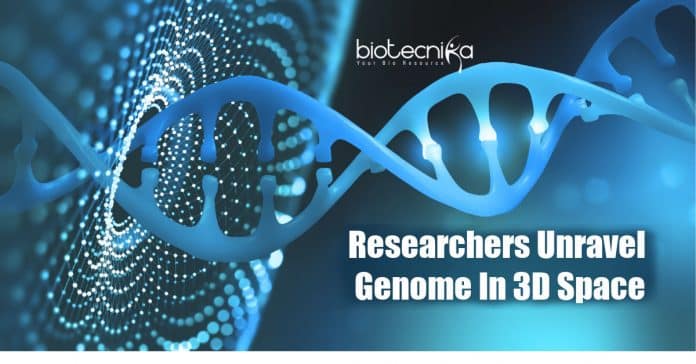Researchers unravel the genome in three-dimensional space
The cells of our body are very small, and each of them is of only micrometers in size. On the other hand, the collection of chromosomal DNA molecules that encode the genome is nearly 2 meters in size. The chromosomal DNA is folded up multiple times so that it fits into cells. However, the DNA is folded in a particular and highly regulated structure rather than compressed into the nucleus in a random manner. The regulation of topological interactions between distant parts is allowed by the spatial organization of chromosomal DNA. This supports transport of the genome across cell generations, correct expression, and maintenance.
Spontaneously occurring break or those resulting from irradiation can cause serious issues as they promote mutations and can eventually cause cancerous tissue. However, not every DNA break has devastating repercussions, given that our cells have innovative means of repairing. Copying the missing info from the duplicated sister chromatid on the damaged DNA is one of the major DNA repair work pathways. The 2 DNA molecules of sister chromatids have to come near together at the correct same genomic posit
ion for this DNA repair work pathways to occur. However, it has actually remained uncertain tat how both DNA molecules are organized about each other to sustain this vital repair work pathway.A technique that fixes this problem was developed by the group around Daniel Gerlich. Michael Mitter, a doctoral student in Dr. Gerlich’s lab and first author of the study stated that the existing techniques to map the folding of DNA have a serious unseen area: They are not able to differentiate similar copies of DNA molecules. Their method to resolve this was to label DNA copies in a manner that they can use DNA sequencing to distinguish them. The initial high-resolution map of contact points within replicated chromosomes was developed by the team using this novel technique.
Gerlich said that using this technique, one can analyze the molecular machinery controlling the conformation of sister chromatids. This will give understanding into the mechanisms behind the repair of DNA breaks and the development of rod-shaped chromosomes in dividing cells, which is needed for correct transport of the genome to cell progeny. Vienna Science and Technology has funded this research.
The outcomes of the study are published in the journal Nature.
Researchers unravel the genome in three-dimensional space
Author: Sruthi S






























